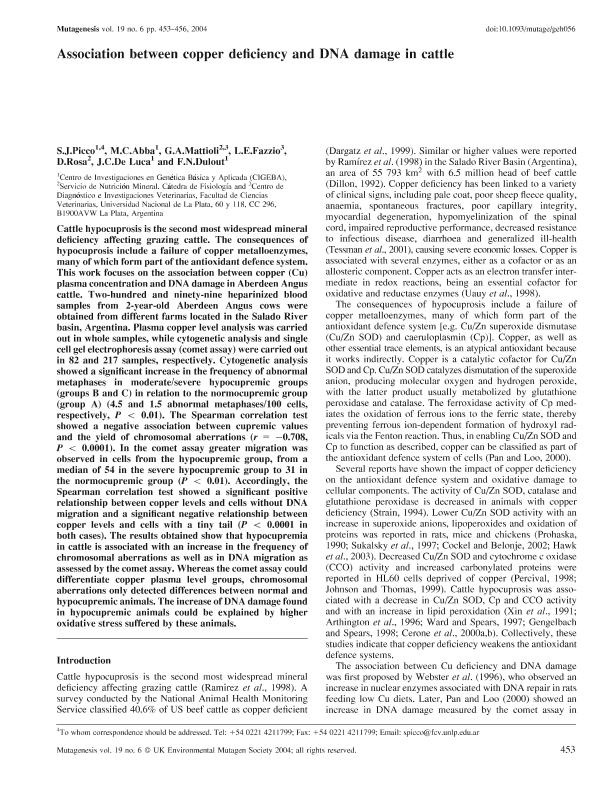Mostrar el registro sencillo del ítem
dc.contributor.author
Picco, Sebastian Julio

dc.contributor.author
Abba, Martín Carlos

dc.contributor.author
Mattioli, Guillermo Alberto

dc.contributor.author
Fazzio, Luis Emilio

dc.contributor.author
Rosa, Diana Esther

dc.contributor.author
de Luca, Julio Cesar

dc.contributor.author
Dulout, Fernando Noel

dc.date.available
2019-09-12T22:36:10Z
dc.date.issued
2004-11
dc.identifier.citation
Picco, Sebastian Julio; Abba, Martín Carlos; Mattioli, Guillermo Alberto; Fazzio, Luis Emilio; Rosa, Diana Esther; et al.; Association between copper deficiency and DNA damage in cattle; Oxford University Press; Mutagenesis; 19; 6; 11-2004; 453-456
dc.identifier.issn
0267-8357
dc.identifier.uri
http://hdl.handle.net/11336/83477
dc.description.abstract
Cattle hypocuprosis is the second most widespread mineral deficiency affecting grazing cattle. The consequences of hypocuprosis include a failure of copper metalloenzymes, many of which form part of the antioxidant defence system. This work focuses on the association between copper (Cu) plasma concentration and DNA damage in Aberdeen Angus cattle. Two-hundred and ninety-nine heparinized blood samples from 2-year-old Aberdeen Angus cows were obtained from different farms located in the Salado River basin, Argentina. Plasma copper level analysis was carried out in whole samples, while cytogenetic analysis and single cell gel electrophoresis assay (comet assay) were carried out in 82 and 217 samples, respectively. Cytogenetic analysis showed a significant increase in the frequency of abnormal metaphases in moderate/severe hypocupremic groups (groups B and C) in relation to the normocupremic group (group A) (4.5 and 1.5 abnormal metaphases/100 cells, respectively, P < 0.01). The Spearman correlation test showed a negative association between cupremic values and the yield of chromosomal aberrations (r = -0.708, P < 0.0001). In the comet assay greater migration was observed in cells from the hypocupremic group, from a median of 54 in the severe hypocupremic group to 31 in the normocupremic group (P < 0.01). Accordingly, the Spearman correlation test showed a significant positive relationship between copper levels and cells without DNA migration and a significant negative relationship between copper levels and cells with a tiny tail (P < 0.0001 in both cases). The results obtained show that hypocupremia in cattle is associated with an increase in the frequency of chromosomal aberrations as well as in DNA migration as assessed by the comet assay. Whereas the comet assay could differentiate copper plasma level groups, chromosomal aberrations only detected differences between normal and hypocupremic animals. The increase of DNA damage found in hypocupremic animals could be explained by higher oxidative stress suffered by these animals.
dc.format
application/pdf
dc.language.iso
eng
dc.publisher
Oxford University Press

dc.rights
info:eu-repo/semantics/openAccess
dc.rights.uri
https://creativecommons.org/licenses/by-nc-sa/2.5/ar/
dc.subject
Copper Deficiency
dc.subject
Dna Damage
dc.subject
Cattle
dc.subject.classification
Ciencias Veterinarias

dc.subject.classification
Ciencias Veterinarias

dc.subject.classification
CIENCIAS AGRÍCOLAS

dc.title
Association between copper deficiency and DNA damage in cattle
dc.type
info:eu-repo/semantics/article
dc.type
info:ar-repo/semantics/artículo
dc.type
info:eu-repo/semantics/publishedVersion
dc.date.updated
2019-09-04T19:27:21Z
dc.journal.volume
19
dc.journal.number
6
dc.journal.pagination
453-456
dc.journal.pais
Reino Unido

dc.journal.ciudad
Oxford
dc.description.fil
Fil: Picco, Sebastian Julio. Consejo Nacional de Investigaciones Científicas y Técnicas. Centro Científico Tecnológico Conicet - La Plata; Argentina. Universidad Nacional de La Plata. Facultad de Ciencias Veterinarias. Centro de Investigaciones en Genética Básica y Aplicada; Argentina
dc.description.fil
Fil: Abba, Martín Carlos. Consejo Nacional de Investigaciones Científicas y Técnicas. Centro Científico Tecnológico Conicet - La Plata; Argentina. Universidad Nacional de La Plata. Facultad de Ciencias Veterinarias. Centro de Investigaciones en Genética Básica y Aplicada; Argentina
dc.description.fil
Fil: Mattioli, Guillermo Alberto. Universidad Nacional de La Plata. Facultad de Ciencias Veterinarias; Argentina
dc.description.fil
Fil: Fazzio, Luis Emilio. Universidad Nacional de La Plata. Facultad de Ciencias Veterinarias; Argentina
dc.description.fil
Fil: Rosa, Diana Esther. Universidad Nacional de La Plata. Facultad de Ciencias Veterinarias; Argentina
dc.description.fil
Fil: de Luca, Julio Cesar. Consejo Nacional de Investigaciones Científicas y Técnicas. Centro Científico Tecnológico Conicet - La Plata; Argentina. Universidad Nacional de La Plata. Facultad de Ciencias Veterinarias. Centro de Investigaciones en Genética Básica y Aplicada; Argentina
dc.description.fil
Fil: Dulout, Fernando Noel. Consejo Nacional de Investigaciones Científicas y Técnicas. Centro Científico Tecnológico Conicet - La Plata; Argentina. Universidad Nacional de La Plata. Facultad de Ciencias Veterinarias. Centro de Investigaciones en Genética Básica y Aplicada; Argentina
dc.journal.title
Mutagenesis

dc.relation.alternativeid
info:eu-repo/semantics/altIdentifier/doi/http://dx.doi.org/10.1093/mutage/geh056
dc.relation.alternativeid
info:eu-repo/semantics/altIdentifier/url/https://academic.oup.com/mutage/article/19/6/453/1053273
Archivos asociados
